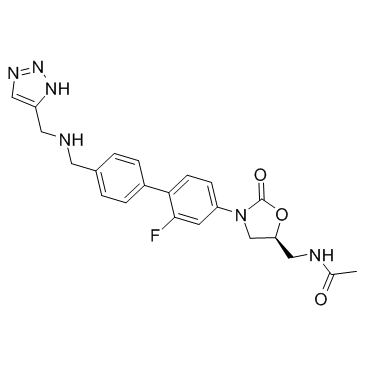| Description |
Radezolid is a novel oxazolidinone antibiotic agent.
|
| Related Catalog |
|
| In Vitro |
Radezolid MICs are systematically equal to or lower (up to 3 log2 dilutions) than those of linezolid for all linezolid-susceptible strains, with an 8-fold difference for the linezolid-resistant strains. Radezolid shows a greater potency than linezolid, independent of the bacteria tested, when concentrations are expressed on a weight (mg/L) basis. Radezolid shows an improved potency compared to that of linezolid when concentrations are expressed on a weight (mg/L) basis[1]. Radezolid and TR-700 perform well against 3-copy G2447T, G2576T, and G2576T/T2571C mutants[2].
|
| Cell Assay |
Antibiotic accumulation is determined following the general procedure, and the cellular content of [14C]radezolid is assayed in cell lysates by liquid scintillation counting (lowest limit of detection, 0.003 mg/liter; linear response between 0.01 and 0.78 mg/liter; R2=0.999). All cell drug contents are expressed by reference to the total cell protein content and converted into apparent total cell concentrations using a conversion factor of 5 μL per mg of cell protein.
|
| References |
[1]. Lemaire S, et al. Cellular pharmacodynamics of the novel biaryloxazolidinone radezolid: studies with infected phagocytic and nonphagocytic cells, using Staphylococcus aureus, Staphylococcus epidermidis, Listeria monocytogenes, and Legionella pneumophila. [2]. Locke JB, et al. Structure-activity relationships of diverse oxazolidinones for linezolid-resistant Staphylococcus aureus strains possessing the cfr methyltransferase gene or ribosomal mutations. Antimicrob Agents Chemother. 2010 Dec;54(12):5337-43.
|


